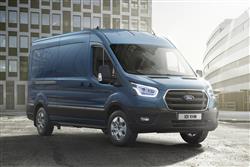Ford Transit [two-tonne] - ABC Leasing
TURKISH DELIGHT(some text hidden)
By Jonathan Crouch
Ten Second Review word count: 64
The sixth-generation Ford Transit two-tonne large van has proved to be a big step forward, but Ford has continued its efforts to try and improve this Turkish-built model. Payloads are up, there's a full EV version, you can now have the brand's SYNC 4 media tech and extra safety kit, plus diesel buyers get EcoBlue Hybrid mild technology. The result is a strong package.
Background word count: 202
If the Ford Transit was a watch, you know it would be a Timex. That old strapline 'Takes a Licking But Keeps on Ticking' is just as appropriate to Ford's hardy perennial, a vehicle that has carved itself a massive share of the UK commercial vehicle market. This sixth generation version has been well received around the world as a global product - it's even sold in the US. Perhaps its one weakness from original though, lay with the relatively inefficient 2.2-litre diesel engines provided beneath the bonnet. No longer. Modern EcoBlue diesel technology (which can be had in 48-volt mild hybrid form) gets Ford back on the pace when it comes to efficiency returns in the large van segment - and not before time. Plus there's now a full EV option too. This design is the biggest version of the Transit breed, there to cover off large van rivals like Mercedes' Sprinter and the Renault Master. The Blue Oval brand these days has a separate smaller Transit Custom model to cover off Vivaro, Trafic and Transporter competitors in the medium-shaped van sector - a product we'll deal with separately. Here though, we look at the super-sized Transit, still a market leader.
Driving Experience word count: 314
The main change for the latest model year is the availability of an eight-speed automatic transmission option for front wheel drive models. Otherwise, it's as you were. Under the bonnet, the 2.0-litre Ford EcoBlue engine is offered in 105PS, 130PS, 170PS and 185PS power ratings. Alternatively, there's an E-Transit all-electric model, which when fully charged, offers a driving range of up to 196 miles in 68kWh Standard Range form or up to 249 miles in Extended range guise. It comes mated to a choice of two electric motor outputs - either 135 or 198kW. For the time being, most customers will continue to want the diesel unit, improved in recent years with greater low down torque and the option of EcoBlue Hybrid 48-volt mild-hybrid powertrain technology for front-wheel-drive and rear-wheel-drive Transit models. in addition to the six-speed automatic gearbox usually specified on front-wheel drive variants, rear-wheel drive Transits are available with a 10-speed automatic transmission featuring Adaptive Shift Scheduling, which can assess individual driving styles to optimise gearshift timings. As it was previously, the Transit is available in front-wheel drive, rear-wheel drive and all-wheel drive versions (plus there are also 'Trail' versions intended for rougher road use). Even in its standard forms, this Ford has been engineered to keep coming back after the worst abuse imaginable. Its body construction features high-strength and ultra-high-strength boron steels and in development, has covered the equivalent of nearly 3.4 million miles in testing in Europe and North America, with more than 250,000 miles of that total covered by actual Transit customers. Safety tests have been undertaken to ensure the van would behave in a safe and predictable manner when subjected to the worst kinds of impacts experienced in real-world use, one test involving striking a 150mm kerb at 30mph. Ford didn't say how much damage the inevitable Pot Noodle in the cup holder did to the vehicle's interior.
Pictures (High res disabled)

.jpg)

Scoring
Category: Compact Car
| Performance | |
| Handling | |
| Comfort | |
| Space | |
| Styling | |
| Build | |
| Value | |
| Equipment | |
| Economy | 80% |
| Depreciation | 60% |
| Insurance | 70% |
| Total | 76% |